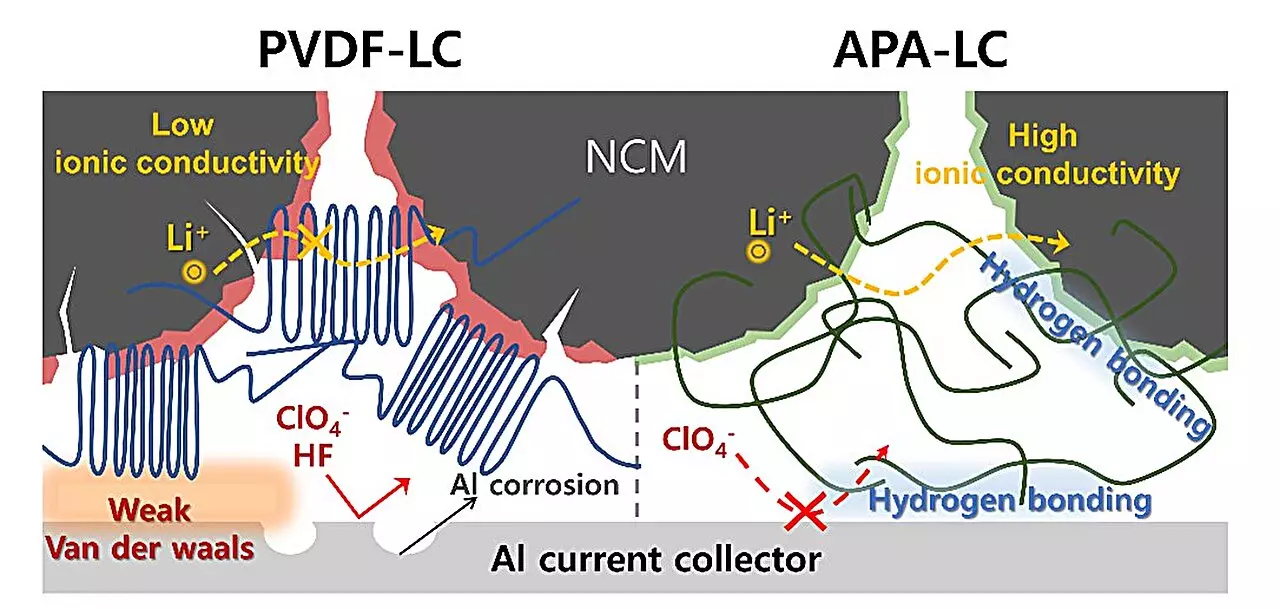In light of growing environmental challenges, the battery industry is witnessing a paradigm shift towards sustainable technologies. Traditional lithium-ion batteries rely heavily on fluorinated compounds, such as polyvinylidene fluoride (PVDF) and lithium hexafluorophosphate (LiPF6). These materials, while effective, pose significant environmental risks—including the release of toxic hydrogen fluoride (HF) during their use and disposal. As global awareness of these hazards increases, alternative solutions must be explored to align battery technology with upcoming environmental regulations, especially in regions like the European Union, which aims to ban per- and polyfluoroalkyl substances (PFAS) by 2026.
Recent advancements by a collaborative research team from Pohang University of Science and Technology (POSTECH) and Hansol Chemical indicate a promising direction for battery innovation. Their novel approach involves the development of a fluorine-free binder and electrolyte system aimed at enhancing both performance and sustainability. By utilizing a lithium perchlorate (LiClO4) electrolyte and a non-fluorinated aromatic polyamide (APA) binder, this new system addresses the dual challenges of performance and ecological responsibility. This innovative “APA-LC” framework not only eliminates harmful fluorinated compounds but also harnesses properties that improve battery performance, making it a viable alternative to traditional systems.
The APA-LC system has demonstrated significant advantages over its PVDF-LP predecessor. The non-fluorinated APA binder plays a crucial role in establishing robust bonds between the cathode’s active materials and the aluminum current collector. By ensuring stronger adhesion, this innovation decreases the risk of electrode corrosion within the electrolyte—a leading factor in battery degradation. The stability of the APA binder effectively prolongs the battery’s lifecycle, a critical consideration in the realm of sustainable technologies.
Moreover, the researchers found that the LiClO4-based electrolyte, particularly when integrated with lithium chloride (LiCl) and lithium oxide (Li2O), facilitates enhanced ion mobility. This translates to faster lithium diffusion rates and improved energy output. In comparative tests, the APA-LC system consistently outperformed traditional systems, showcasing a standout 20% higher capacity retention over 200 charge/discharge cycles, even under rapid operational conditions. This resilience not only exemplifies the system’s potential for high-capacity applications but also positions it as an environmentally friendly alternative to conventional battery technologies.
One of the most notable achievements of this research team is their successful creation of a high-capacity pouch cell capable of delivering excellent discharge performance during fast-charging trials. The practicality and scalability of this battery system mark a significant milestone. By eliminating fluorinated materials entirely, the newly developed system aligns with environmental sustainability concerns while retaining high performance.
According to Professor Soojin Park from POSTECH, this innovation signifies more than just a replacement of existing materials; it establishes a benchmark for future advancements in battery sustainability. The demonstrated reliability and efficiency of the APA-LC system raises the prospect of a broader industry transition towards non-fluorinated battery technologies.
The implications of this breakthrough are far-reaching. As regulatory frameworks tighten around PFAS substances, industries are compelled to adopt greener alternatives. Young-Ho Yoon, Managing Director of Hansol Chemical’s Secondary Battery Materials Business, highlighted the potential for significant market influence, with projections indicating the global cathode binder market may soar to KRW 1.7 trillion by 2026. The team’s ongoing research endeavors aim to fortify their position as a frontrunner in the eco-friendly battery materials market.
This research not only signifies a leap towards environmentally compliant battery technology but also exemplifies how innovation can fulfill performance metrics without compromising ecological integrity. Our energy future hinges on advancements like these, emphasizing the urgent need to pivot towards sustainable alternatives as we aim for a balance between technological development and environmental stewardship. The findings from POSTECH and Hansol Chemical serve as a catalyst for change within the battery industry, heralding a new era of responsible energy solutions.

